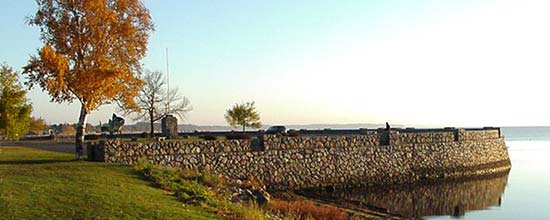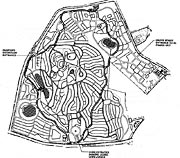

Guidelines for Restoring Cultural Landscapes
Circulation

Identify, Retain, and Preserve Historic Features and Materials from the Restoration Period
![]()
Identifying, retaining and preserving the existing circulation features from the restoration period prior to beginning project work. All circulation features should be documented, from small paths and walks to larger transportation corridors such as parkways, highways, railroads and canals. Documenting alignment, surface and edge treatment, width, grade, materials and infrastructure.
Evaluating and understanding the cultural landscape’s circulation from the restoration period. Using archival resources such as plans and aerial photographs, or, in their absence, archeological analysis techniques to understand the circulation from the restoration period.
![]()
Executing project work that impacts circulation from the restoration period. For example, altering the route and configuration of a historic bridle path without identifying its historic alignment.
Executing project work without understanding its impact on circulation features from the restoration period. For example, changing road widths without a thorough evaluation of the historic road.
Protect and Maintain Features and Materials from the Restoration Period
![]()
Protecting and maintaining circulation features from the restoration period by use of non-destructive methods and daily, seasonal and cyclical tasks. For example, this may include hand-raking, top-dressing, or rolling surface materials.
![]()
Failing to undertake preventive maintenance for circulation features from the restoration period. For example, permitting a failed drainage system to contribute to the degradation and loss of associated curbs or erosion of shoulders.
Utilizing maintenance methods which destroy or degrade circulation features from the restoration period. For example, using a snow plow over a coarse textured pavement.
Repair Features and Materials from the Restoration Period
![]()
Repair declining circulation features from the restoration period by reinforcing the materials that comprise these features. Repairs will also generally include the limited replacement in-kind or, with compatible substitute material, of those extensively deteriorated or missing parts of features when there are surviving prototypes. For example, replacing in-kind limited sections of capstone along a historic parapet. The new work should be unobtrusively dated to guide future research and treatment.
![]()
Replacing or destroying circulation features from the restoration period when repair of materials and limited replacement of deteriorated or missing components are appropriate.
Failing to reuse existing surface or edge materials from the restoration period when only the substrate requires repair.
Using a substitute material for the replacement part that does not convey the visual appearance of the surviving parts of the circulation feature from the restoration period, or that is physically or environmentally incompatible.
Replace Extensively Deteriorated Features from the Restoration Period
![]()
Using physical evidence of form, detailing and alignment to reproduce an entire circulation feature from the restoration period. If using the same kind of material is not technically, economically, or environmentally feasible, then a compatible substitute material may be considered. The new work should be unobtrusively dated to guide future research and treatment. For example, replacing a bulkhead’s timber coping along an entire waterfront esplanade.
![]()
Removing a circulation feature from the restoration period that is unrepairable and not replacing it; replacing it with a new feature that does not convey the same visual appearance; or failing to document the new work. For example, removing a crushed stone carriage road and replacing it with a wider asphalt road.
Remove Existing Features from Other Historic Periods
![]()
Removing or altering circulation features from other historic periods. For example, removing a later parking lot.
Documenting circulation features from other historic periods prior to their alteration or removal. For example, recording cross sections of road and retaining wall construction. If possible, representative features should be stored for future research.
![]()
Failing to remove circulation features from another period, thus confusing the depiction of the landscape during the restoration period. For example, maintaining a modern asphalt path through a historic meadow.
Failing to document circulation features from other historic periods that are removed or altered so that a valuable portion of the historic record is lost.
Re-Create Missing Features from the Restoration Period
![]()
Recreating a missing circulation feature that existed during the restoration period based on historical, pictorial and physical documentation. For example, duplicating paving patterns based on surviving prototypes.
![]()
Constructing a circulation feature that was thought to have existed during the restoration period, but for which there is insufficient information; or constructing a circulation feature that was part of the original design but was never executed, thus creating a false historic appearance.
The Garrison Concourse is one of the historically significant circulation features to be preserved and protected as part of the Minnesota Department of Transportation's Roadside program (MNDOT)
The layout of the circulation system is the centerpiece of Mount Auburn’s landscape design, and the least changed aspect of it. Today there are about 70 miles of paths and 12 miles of roads. The chronological development of the cemetery’s access, circulation and parking has resulted in the proposal for protecting and retaining , and in places, restoring the historic circulation design. (The Halvorson Company)
